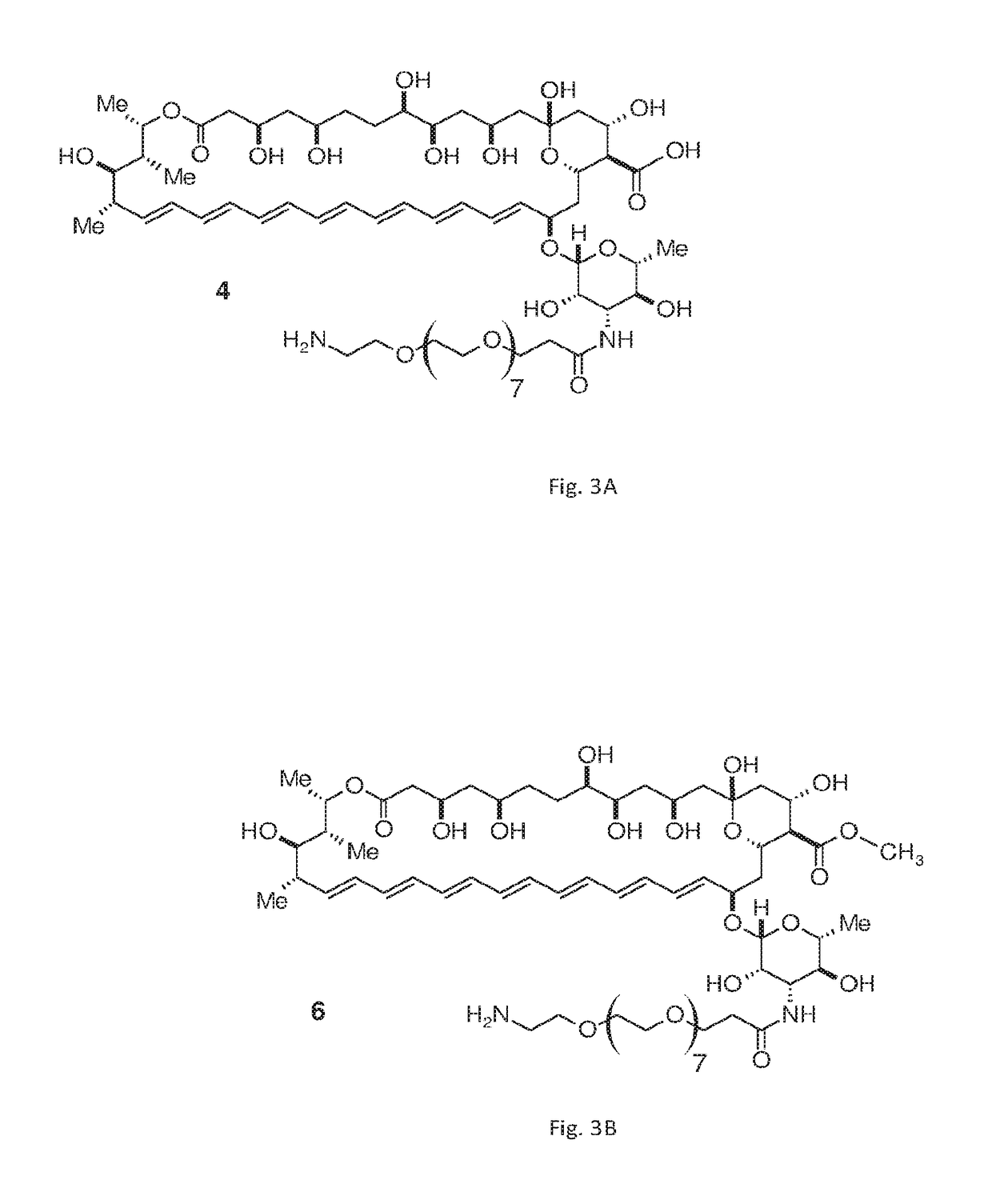Amphotericin B derivatives
a technology of amphotericin and derivatives, which is applied in the field of derivatives of amphotericin b, can solve the problems of high mortality rate of systemic fungal infections, amb has been associated with a variety of potentially harmful side effects, so as to improve antifungal activity, reduce toxicity, and increase solubility
- Summary
- Abstract
- Description
- Claims
- Application Information
AI Technical Summary
Benefits of technology
Problems solved by technology
Method used
Image
Examples
example 1
, Manufacture of Compound 4
[0049]FIG. 3A depicts compound 4, a PAD-AMB according to embodiments of the invention. Compound 4 is amphotericin B amide-PEG(8)-amine. Compound 4 was synthesized as follows:
[0050]Amphotericin B (50 mg, 1 equivalent, available from Appollo Scientific, UK) was reacted with FMOC-protected N-hydroxysuccinimide ester of PEG having 8 PEG monomers (compound 2 of FIG. 2 wherein n is 7, R1 is FMOC, R2 is ethyl and R3 is H, 49.5 mg, 1.2 equivalents, available from Iris Biotech GmbH, Germany) in 2 milliliters (ml) dry DMF in the presence of pyridine (1.2 equivalents) while stirring under inert atmosphere (argon) and exclusion of light for 23 h. The reaction mixture was poured into excess cold diethyl ether, washed twice with ether and dried under vacuum. The product was purified on a silica gel column (CHCl3 / MeOH / H2O 10:4:0.3, Rf=0.64) to give a corresponding FMOC-protected amine derivative as a pale yellow powder (40 mg, 47% yield). The FMOC group was then removed ...
example 2
, Manufacture of Compound 6
[0051]FIG. 3B depicts compound 6, a PAD-AMB according to embodiments of the invention. Compound 6 is amphotericin B amide, methyl ester-PEG(8)-amine, having 8 PEG monomers. Compound 6 was synthesized as follows: FMOC-protected amine derivative of compound 4 was prepared as described in Example 1. 50 mg, 1 equivalent of the FMOC-protected amine was dissolved in 2 ml dry DMF, cooled on ice and (trimethylsilyl)diazomethane solution (4 equivalents, 2.0 M in hexanes) was added and brought to room temperature, followed by stirring for 3 h. The reaction mixture was poured into excess cold diethyl ether, washed twice with ether and dried under vacuum. The product was purified on a silica gel column (CHCl3 / MeOH / H2O 10:1.7:0.05, Rf=0.43) to give the methyl ester of the FMOC-protected amine as a pale yellow powder (13.61 mg, 27% yield). The FMOC group was removed as described in Example 1. The final product was purified by flash chromatography (CHCl3 / MeOH / H2O 10:4:0....
example 3
re of Derivatives of AMB Comprising p PEG Monomers (PEG(p)), an Amine Group and an Amide Linker
[0052]Compounds were manufactured having different numbers of PEG monomers, using the synthetic procedures described in example 1 (for carboxylic acid compounds) and in example 2 (for methyl ester compounds) using the FMOC-protected N-hydroxysuccinimide ester having the appropriate number of PEG monomers. The molecular weight and shorthand name of the compounds, and their structure according to general formula [II] are listed in Table 1 below, in which “AMB” is shorthand for Amphotericin B and “AME” is shorthand for Amphotericin methyl ester:
[0053]
TABLE 1NamepRMolecular weightAMB-PEG4-amine3H1171AME-PEG4-amine3CH31185AMB-PEG44-amine43H2602AME-PEG44-amine43CH32616
PUM
| Property | Measurement | Unit |
|---|---|---|
| concentration | aaaaa | aaaaa |
| time | aaaaa | aaaaa |
| volume | aaaaa | aaaaa |
Abstract
Description
Claims
Application Information
 Login to View More
Login to View More - R&D
- Intellectual Property
- Life Sciences
- Materials
- Tech Scout
- Unparalleled Data Quality
- Higher Quality Content
- 60% Fewer Hallucinations
Browse by: Latest US Patents, China's latest patents, Technical Efficacy Thesaurus, Application Domain, Technology Topic, Popular Technical Reports.
© 2025 PatSnap. All rights reserved.Legal|Privacy policy|Modern Slavery Act Transparency Statement|Sitemap|About US| Contact US: help@patsnap.com



